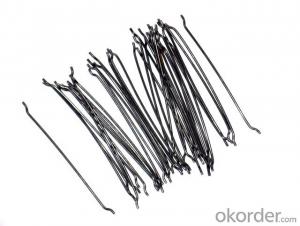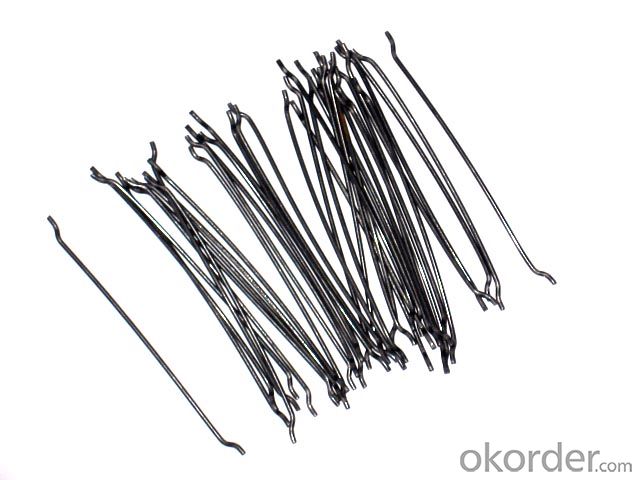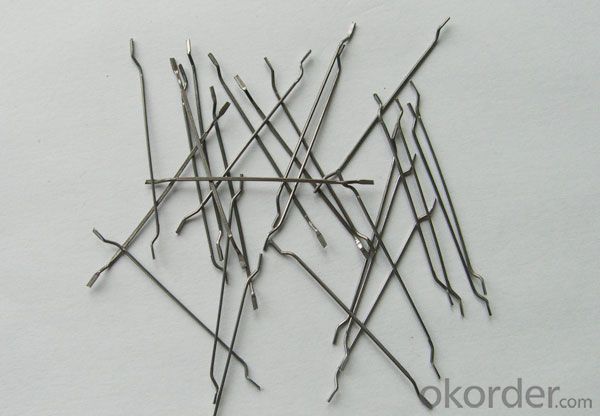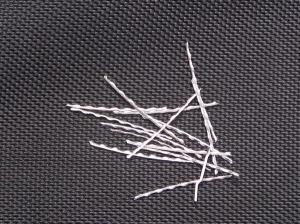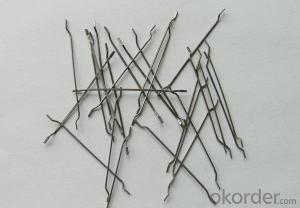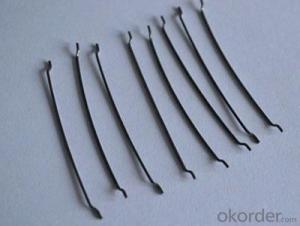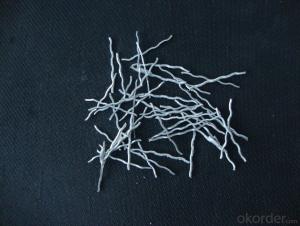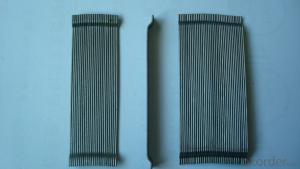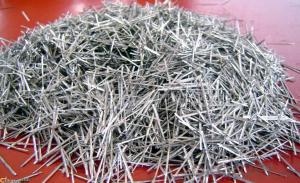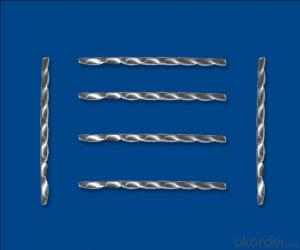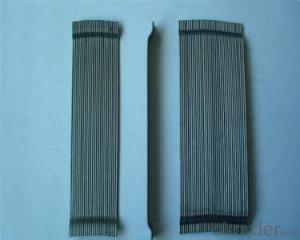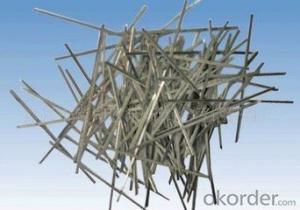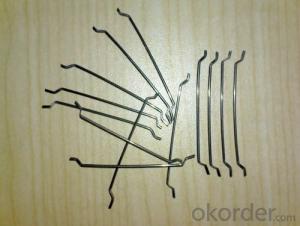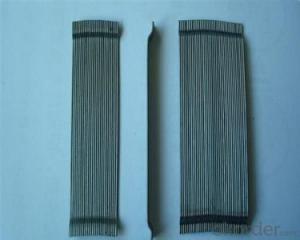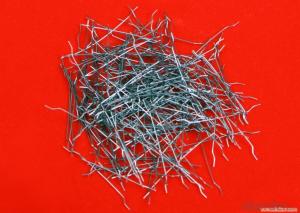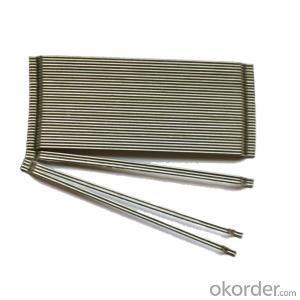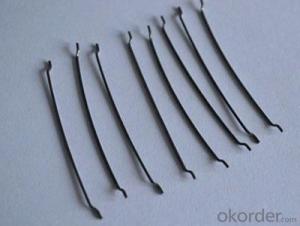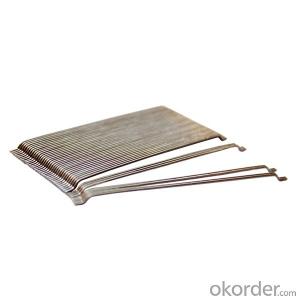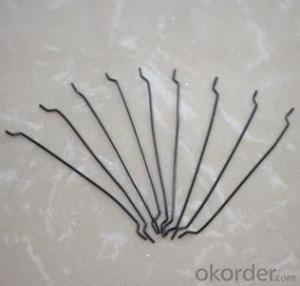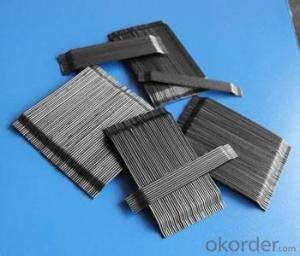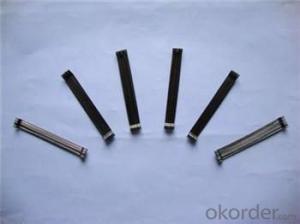Melt Extract Stainless Steel Fiber Loose CNBM International China
- Loading Port:
- Tianjin
- Payment Terms:
- TT OR LC
- Min Order Qty:
- 1000 kg
- Supply Capability:
- 30000 kg/month
OKorder Service Pledge
OKorder Financial Service
You Might Also Like
Quick Details
Place of Origin: Jiangsu, China (Mainland)
Model Number: HT-MC
Material: Color Steel
certificated: ISO 9001
Specifications
The raw material is stainless steel ingots, using electric stoves which melt the stainless steel ingots to become 1500 ~ 1600 ℃ steel liquid, and then with a grooved high speed rotating melt-extracting steel wheel which produces wires that meets are our customers’ specific requirements. When melting down to a wheel steel liquid surface, the liquid steel blow out by slot with centrifugal force at extremely high speed with cooling forming. Melting wheels with water keep the cooling speed. This method is done to produce different material, different sizes of steel fiber.
SIZE | CHEMIC ELEMENT(%) | ||||||
C | P | Mn | Si | Cr | Ni | Al | |
AISI330 | ≤0.40 | ≤0.04 | ≤2.00 | ≤0.75 | 17~20 | 33~37 | |
AISI310 | ≤0.40 | ≤0.04 | ≤2.00 | ≤1.50 | 24~26 | 19~22 | |
AISI316 | ≤0.40 | ≤0.04 | ≤2.00 | ≤1.00 | 16~18 | 10~14 | |
AISI314 | ≤0.40 | ≤0.045 | ≤2.00 | 1.5-3.0 | 23~26 | 19~22 | |
AISI309 | ≤0.40 | ≤0.04 | ≤2.00 | ≤1.00 | 22~24 | 12~15 | |
AISI304 | ≤0.40 | ≤0.04 | ≤2.00 | ≤2.00 | 18~20 | 8~10 | |
AISI301 | ≤0.40 | ≤0.04 | ≤2.00 | ≤2.00 | 16~18 | 6~8 | |
AISI201 | ≤0.40 | ≤0.06 | 5.5~7.5 | ≤1.00 | 16~18 | 3.5~5.5 | |
AISI446 | ≤0.40 | ≤0.04 | ≤1.50 | ≤2.00 | 23~27 | ||
AISI430 | ≤0.40 | ≤0.03 | ≤1.00 | ≤2.00 | 16~18 | ||
NAS430A | ≤0.40 | ≤0.03 | ≤0.50 | ≤0.50 | 16~18 | 2~4 | |
SIZE(mm) | ||||
length | 20 | 25 | 30 | 35 |
width | 0.75~1.5 | 0.75~1.5 | 0.75~1.5 | 0.75~1.5 |
thickness | 0.2~0.75 | 0.2~0.75 | 0.2~0.75 | 0.2~0.75 |
Picture
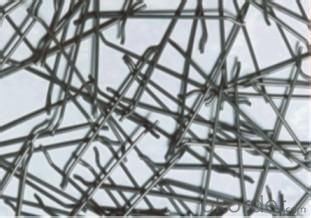
Steel fiber
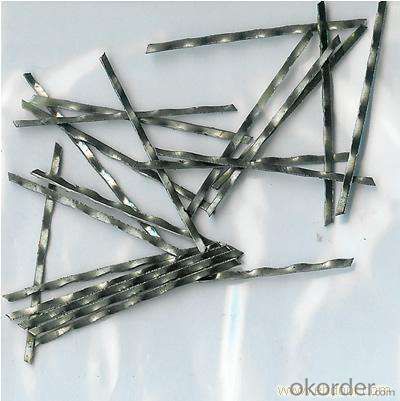
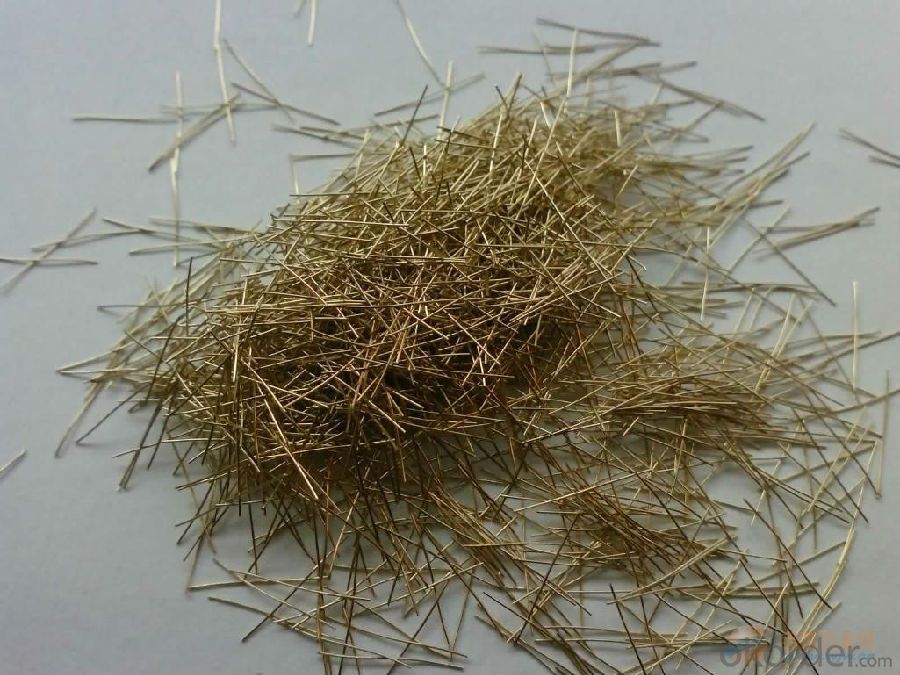
FAQ
1. Metallurgical industry
The refining outside the furnace airbrush, dipping tubes, slag dam, bag lining cover, the triangle electric furnace, furnace cover, the molten iron trench cover, the torpedo cans, coke oven door, the heating furnace of steel rolling door, furnace roof, burn tsui, annular furnace baffle wall, hearth roll, forging steel furnace, steel tanks etc, items can be used for various refractory kiln linings.
2. The construction industry
Steel fiber mixed with mixes clay is rapid development of new composite materials in recent years, especially for the steel fiber concrete fastest development. Steel fiber with excellent tensile, bending, shear and crack resistance, impact resistance, resistance to fatigue, high toughness properties, are all items widely used in construction, road, bridge, tunnel, airport pavement, hydraulic harbor, military engineering, all kinds of buildings and products etc.
3. Kiln
Sintering furnace, reduction furnace, finer, the flue, furnace burning tsui and other heat-resistant linings.
4. Petroleum chemical industry
Especially in the refining the lining of catalytic cracking units.
5. Electric power industry
Thermal power plant boiler heat resistant linings.
6. Environmental protection industry
Incinerator.
- Q: Can melt extract stainless steel fiber be used in tunnel shotcrete lining applications?
- Yes, melt extract stainless steel fiber can be used in tunnel shotcrete lining applications. This type of fiber is commonly used to enhance the mechanical properties of shotcrete, such as its tensile strength, flexural strength, and impact resistance. Additionally, melt extract stainless steel fibers can improve the durability and durability of shotcrete, making it suitable for tunnel applications where long-term performance is critical. These fibers are typically mixed into the shotcrete mixture and contribute to the overall structural integrity of the tunnel lining. Overall, melt extract stainless steel fibers are a reliable and effective solution for reinforcing tunnel shotcrete linings.
- Q: Are there any specific curing requirements for concrete with melt extract stainless steel fiber?
- Concrete with melt extract stainless steel fiber has specific curing requirements that need to be addressed. It is important to understand that the inclusion of stainless steel fibers in concrete can greatly improve its mechanical properties, such as tensile strength and resistance to cracking. However, these fibers can also impact the curing process, necessitating certain considerations. One crucial requirement is the need for adequate moisture during the curing process. It is essential to keep concrete with stainless steel fibers moist to prevent premature drying, which can result in shrinkage and cracking. To retain moisture and ensure proper hydration, moist curing methods like using wet burlap or plastic sheets can be employed. Temperature control is another critical aspect of the curing period. High temperatures can accelerate the hydration process, leading to increased shrinkage and potential cracking. Conversely, low temperatures can hinder curing and result in reduced strength development. Therefore, maintaining a moderate and consistent temperature is vital for the proper curing of concrete with stainless steel fibers. Moreover, it is advisable to prolong the duration of the curing period for concrete with stainless steel fibers. The presence of fibers can impede water movement within the concrete matrix, slowing down hydration. By extending the curing time, the concrete has more opportunity to develop the desired strength and durability. Lastly, it is crucial to adhere to the manufacturer's recommendations regarding curing requirements for concrete with melt extract stainless steel fibers. Different fiber types and manufacturers may have specific guidelines and recommendations for curing, which should be followed to ensure optimal performance of the concrete. To summarize, the curing requirements for concrete with melt extract stainless steel fibers involve maintaining moisture, controlling temperature, extending the curing period, and following manufacturer guidelines. By fulfilling these requirements, the concrete can achieve its desired strength and durability while benefiting from the enhanced properties provided by the stainless steel fibers.
- Q: Can melt extract stainless steel fiber be used in self-compacting concrete mixtures?
- Yes, melt extract stainless steel fiber can be used in self-compacting concrete mixtures. The addition of stainless steel fibers enhances the properties of self-compacting concrete, such as improving its durability, crack resistance, and mechanical strength.
- Q: What is the effect of melt extract stainless steel fiber on the thermal conductivity of concrete?
- The inclusion of melt extract stainless steel fiber in concrete can significantly improve the thermal conductivity of the material. Stainless steel fibers have excellent thermal conductivity properties, meaning they can efficiently transfer heat throughout the concrete. When these fibers are added to the concrete mix, they form a three-dimensional network that helps to conduct and distribute heat more effectively. This enhanced thermal conductivity can have several positive effects on the concrete's performance. Firstly, the increased thermal conductivity can improve the overall thermal efficiency of structures built with this type of concrete. It allows for better heat transfer, which can help regulate temperatures more efficiently, reducing the need for additional insulation or heating and cooling systems. Additionally, the improved thermal conductivity can also enhance the durability of the concrete. By evenly distributing heat and minimizing temperature gradients, the risk of thermal cracking and damage due to thermal expansion and contraction is reduced. This is especially beneficial in environments with significant temperature variations. Moreover, the higher thermal conductivity provided by melt extract stainless steel fiber can also be advantageous in applications such as radiant floor heating systems. The fibers can efficiently transfer heat from the heating elements to the surface, resulting in more efficient and effective heating. In summary, the inclusion of melt extract stainless steel fiber in concrete significantly enhances its thermal conductivity. This improvement can lead to increased thermal efficiency, improved durability, and better performance in various applications where heat transfer is a critical factor.
- Q: How does the addition of melt extract stainless steel fiber affect the creep behavior of concrete?
- The addition of melt extract stainless steel fiber positively affects the creep behavior of concrete. Creep is the time-dependent deformation of concrete under a constant load, and it is a significant concern in structural applications as it can lead to long-term deformation and structural failure. When melt extract stainless steel fibers are incorporated into the concrete mix, they enhance the overall mechanical properties of the material. The fibers act as reinforcement, providing additional tensile strength and improving the concrete's resistance to cracking and deformation. The steel fibers also contribute to reducing the overall creep of concrete. They act as internal support, resisting the movement and redistribution of stresses within the concrete matrix. This reinforcement effect helps to distribute the applied load more evenly and reduces the potential for long-term deformation. Furthermore, melt extract stainless steel fibers improve the durability of concrete by increasing its resistance to environmental factors such as shrinkage, thermal cycling, and aggressive chemicals. This enhanced durability contributes to the long-term stability and performance of concrete structures. In summary, the addition of melt extract stainless steel fibers to concrete improves its creep behavior by enhancing its mechanical properties and reducing the potential for long-term deformation. This reinforcement effect leads to increased structural integrity and durability, making it an effective solution for applications where creep resistance is a concern.
- Q: Can melt extract stainless steel fiber be used in parking garage structures?
- Indeed, parking garage structures can utilize melt extract stainless steel fiber. This type of fiber, derived from stainless steel, is frequently employed as a reinforcement material in concrete to bolster its sturdiness and longevity. By incorporating melt extract stainless steel fiber, the resistance of concrete structures to cracking, impact, and corrosion can be notably enhanced, rendering it an optimal choice for parking garages. This particular type of stainless steel fiber has been specially engineered to possess exceptional tensile strength and impeccable adhesion with concrete, ensuring the stability and durability of the parking garage. Moreover, the stainless steel composition provides resistance against rusting and deterioration, a vital characteristic for structures exposed to harsh environmental elements, such as parking garages. All in all, the utilization of melt extract stainless steel fiber in parking garage structures can profoundly augment their structural integrity and lifespan.
- Q: The heavy steel fiber feifanshi supeiflat floor for what?
- Feifanshi steel fiber heavy-duty supeiflat floor walk forklift high level rack of logistics distribution center
- Q: Can melt extract stainless steel fiber improve the bond strength of concrete to epoxy coatings?
- The use of melt extract stainless steel fiber is effective in enhancing the bond strength between concrete and epoxy coatings. Stainless steel fibers are frequently employed as reinforcement in concrete to increase its tensile strength and durability. Once incorporated into concrete, these fibers aid in the distribution and dissipation of stress, thereby minimizing crack formation and enhancing the overall structural integrity. In the context of epoxy coatings, the inclusion of melt extract stainless steel fibers offers numerous advantages. Firstly, these fibers serve as mechanical anchors, improving the bond between the concrete and the epoxy coating. This enhanced bond strength ensures that the coating remains securely attached to the concrete surface, even when subjected to stress or movement. Secondly, the presence of stainless steel fibers also helps in reducing crack formation within the epoxy coating. By reinforcing the concrete substrate, these fibers distribute any stress or load applied to the coating more evenly, thus reducing the likelihood of crack formation due to localized stress concentrations. Moreover, melt extract stainless steel fibers contribute to the overall durability and lifespan of the epoxy coating. They provide added protection against impact, abrasion, and other forms of wear and tear that the coating may experience over time. This increased durability results in epoxy coatings that are longer-lasting and more resilient. In conclusion, the addition of melt extract stainless steel fiber significantly improves the bond strength between concrete and epoxy coatings. By enhancing the mechanical connection and providing additional reinforcement, these fibers contribute to a stronger, more durable, and longer-lasting bond.
- Q: How does melt extract stainless steel fiber improve the resistance to cracking in concrete?
- The unique properties and characteristics of melt extract stainless steel fiber contribute to the improvement of crack resistance in concrete. By reinforcing the material, the fibers provide additional tensile strength and ductility when mixed into the concrete. Uniformly dispersed throughout the concrete matrix, the stainless steel fibers form a three-dimensional network that enhances the overall structural integrity. This network effectively distributes and absorbs stresses, preventing cracks from forming and spreading. Furthermore, the high aspect ratio of the fibers, combined with their strong bond to the concrete matrix, enhances the material's load-bearing capacity. As a result, the stainless steel fibers act as micro-reinforcements when exposed to external forces or thermal changes, effectively resisting crack formation and reducing crack width and length. The corrosion resistance of stainless steel fibers is also a significant advantage. Unlike other types of fibers, stainless steel does not corrode even in harsh environments or when exposed to chemicals. This corrosion resistance ensures the long-term durability of the concrete structure, preventing the deterioration of its mechanical properties. Moreover, the inclusion of melt extract stainless steel fibers reduces shrinkage and creep in concrete, which are common causes of cracking. As the concrete dries and cures, shrinkage occurs, often leading to cracks. However, the addition of stainless steel fibers minimizes overall shrinkage, reducing the potential for cracks to form. In conclusion, melt extract stainless steel fibers greatly enhance the crack resistance of concrete. These fibers improve tensile strength, ductility, load-bearing capacity, and corrosion resistance, resulting in a more durable and long-lasting concrete structure.
- Q: Can melt extract stainless steel fiber be used in shotcrete applications?
- Indeed, shotcrete applications can incorporate melt extract stainless steel fiber. Shotcrete entails the application of concrete or mortar via a high-pressure hose, and the inclusion of stainless steel fibers can augment the shotcrete's effectiveness and durability. Typically, melt extract stainless steel fibers are introduced into the shotcrete mixture to enhance its resistance to cracking, diminish shrinkage, and bolster its tensile and flexural strength. Moreover, these fibers aid in regulating crack formation and impede their propagation, resulting in a shotcrete structure that is more enduring and long-lasting. Consequently, the integration of melt extract stainless steel fiber in shotcrete applications can substantially heighten the overall performance and longevity of the shotcrete.
Send your message to us
Melt Extract Stainless Steel Fiber Loose CNBM International China
- Loading Port:
- Tianjin
- Payment Terms:
- TT OR LC
- Min Order Qty:
- 1000 kg
- Supply Capability:
- 30000 kg/month
OKorder Service Pledge
OKorder Financial Service
Similar products
Hot products
Hot Searches
Related keywords
